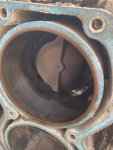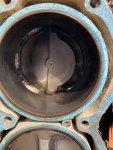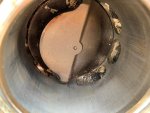Thanks guys. I'm really not sure what's up with it, which is really why I'm leaning towards just getting a rebuilt block. I basically "picked" the motor (and boat/trailer) out of a farmers field for $100. She didn't know the history of it other than it was her nephews boat. He had parked it there over 4 years ago and then got sent to jail (yes, I did get all of the titles... that was a requirement). She was tired of it sitting there and he wanted nothing to do with it anymore, so I got it for a steal.
Anyway, here's what I have done since picking it up. Flywheel turns freely, no binding. Control cables are good. Had to fill and bleed the tilt/trim system before I could get it off the hull. Then I pulled the carbs, inspected, and cleaned/rebuilt them. Then I drained the lower unit (was still full, no water or metal) and pulled it off. Water pump needs to be rebuilt of course. Electrical mostly checked out on the motor, surprisingly (though the rest of the wiring in the hull is shot). Fuel lines are also shot. The batteries were both toast so I pulled the battery from my travel trailer (a dual purpose 550CCA) and hooked it up. I pulled all 4 plugs and inspected. Didn't seem out of the ordinary and all 4 basically looked the same. I gave each cylinder a squirt of 2cycle oil and manually turned the flywheel to coat. Jumping the solenoid, I was only getting about 70-75# across all 4 cylinders, but then I realized my RV battery was only at 12.3V and it was a slow cranking. So while the battery was charging, I put more 2cycle oil in the cylinders, pulled the starter off and took it apart. All looked good, plenty of life in the brushes. I lubed it up, reassembled, and reinstalled. With the fresh battery, I applied voltage directly to the starter, bypassing the solenoid. Crank was much better, and that is where I was getting the current numbers. I checked again jumping he solenoid and got pretty much the same numbers.
Is my gauge off? I don't know. I've only used it a half-dozen times, but it's been YEARS since the last time I've used it. Next time I have to head to town (an hour trip), I'll see if I can borrow a gauge for comparison. I did pull the heads, though. Plenty of water corrosion in the water passages, but the actual cylinders and pistons look fine for the age of the engine. Heads barely have any sign of carbon. No pitting or embedded metal. All 4 cylinders were free of any debris. A small bit of carbon build up inside, but I've seen worse. Left bank (#2 and #4) basically look and feel perfect otherwise. A fingernail doesn't catch on anything. Doesn't seem to be any heat marks or anything else indicating a problem. Right bank (#1 and #3) both have a tiny chip out of the edge of the piston. #3 has no grooves for a fingernail to catch, but #1 has the slightest of scratches that you can just barely feel (but a fingernail still doesn't catch on). Otherwise, that bank looks and feels like the left bank.The small chips on the right bank COULD be a ring, but the fact that I get dang near the exact same compression numbers on all 4 cylinders, I'm not convinced.
Right now I'm leaning towards either my gauge being off, still a slow crank (I'm not sure how to tell for sure if it's cranking slow or not), or something internal. Like I said originally, I'm going to invest the time and money into rebuilding the hull so I'm also leaning towards investing the money into the "new" powerhead. I suppose I wouldn't really be out anything but my time to bolt it all back up and run it on the muffs to see just how it runs (or doesn't run, if that is the case). I'm sure that will help me come to a better conclusion.
Sorry to go down this little side journey. It's not really what I intended this thread to be. I'll snap some pictures of the cylinders tomorrow and upload to see if you guys spot something that my untrained eye didn't.





























